#history of crime and punishment
Text
""That's right, pal," says Number Seven. "And take it in these shops. If they'd even teach a guy a trade - make him learn a trade you wouldn't mind. Then a guy would have something to fall back on if he felt like hitting the straight and narrow. But what do they do? They put you to work making automobile plates, or something that's only done in prisons; stuff you couldn't get a job at outside if you wanted to; and the machinery is all twenty years out of date; and the instructors don't know anything about up-to-date methods; and the materials you get to work with are so lousy that you can't learn to do decent work even if you want to. Here I am. I've been working in the shoeshop for five years. What good will that do me? In the first place, the work I'm doing is done by women and children outside; it don't pay any- thing; and if I tried to get away with the lousy kind of work I've been taught to do, I wouldn't last two hours in an outside shop. The print shop is the only shop in here where a guy could learn a decent trade; but Christ, there's only room for forty guys in that shop, and you have to be a high-school graduate to get in there. That don't do the rest of us any good. There's a thousand men here, and only room for forty or so over in the print shop. And not only that, but So-and-So was always threatening to close the print shop because it didn't show enough profits. That's all they think about here. They damn about us learning a trade; all they is having the industries show a profit!"
"And take a guy when he gets out of here," says Number Ten. "Times are lousy outside. Even guys who know their trades, guys that can get swell references, can't get a job nowadays. And if they can't get work, how in the name of Christ are we going to get it even if we want it? And the jobs you can get don't pay anything - not enough to live on. A guy might better be in here than out there starving to death. How the hell is a guy going to live on twenty-five or thirty bucks a week, especially if he's married?"
- Victor F. Nelson, Prison Days and Nights. Second edition. With an introduction by Abraham Myerson, M.D. Garden City: Garden City Publishing Co., 1936. p. 213-214.
#words from the inside#prisoner autobiography#prison industries#released from prison#prison labor#failure of rehabilitation#american prison system#prison routine#prison days and nights#victor nelson#history of crime and punishment#convict labour#reading 2024
72 notes
·
View notes
Text
watching my gay little doctor show and my gay little religion show and my gay little time travel show and my gay little english high society show and my gay little starfleet shows and reading my gay little dostoevsky books and my gay little donna tartt books and my gay little mary shelley books and listening to my gay little rock songs and my gay little classical pieces and watching my gay little—
#the bisexual experience#the nonbinary vibe#house md#hilson#hugh laurie#good omens#ineffable husbands#doctor who#david tennant#peter capaldi#jeeves and wooster#jooster#star trek#fyodor dostoevsky#crime and punishment#raskolnikov/razumikhin#donna tartt#the secret history#the little friend#the goldfinch#mary shelley#frankenstein#tchaikovsky#and many more#starlightseraph’s brainrot
489 notes
·
View notes
Text
when you read Homer, Dante, Dostoyevsky etc and want to be a classicist but the boy you like can’t even spell correctly
#dark academia#the secret history#henry winter#richard papen#bunny corcoran#dante#dante inferno#dostoevksy#fyodor dostoevsky#crime and punishment#sylvia plath#donna tartt#classics#classic academia#classicism#the bell jar
714 notes
·
View notes
Text

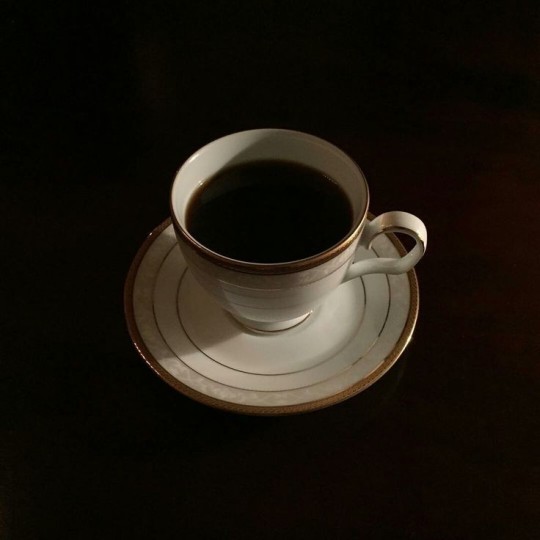


#dark acadamia aesthetic#classic books#crime and punishment#classic academia#dark academia vibes#dark acamedia#fall aesthetic#fall#university#books and libraries#books and coffee#books and reading#dark academia books#books and literature#cofeetime#the secret history
884 notes
·
View notes
Text
Crime and Punishment son or The Secret History daughter?
#gay son or thot daughter#crime and punishment#dostoevksy#fyodor dostoevsky#dark academia#raskolnikov#rodion romanovich raskolnikov#the secret history#tsh#tsh donna tartt#donna tartt#henry winter#francis abernathy#camilla macaulay#charles macaulay#bunny corcoran#julian morrow#romanticism#chaotic academia#literature#russian literature#classical literature
236 notes
·
View notes
Text

FLASHBACK: Nazi apologia - Benjamin Netanyahu said that “Hitler didn't want to exterminate the Jews.”
According to Netanyahu, Adolph Hitler did not want to kill Jewish people, it was Palestinians who convinced and coerced him. (source)
Fortunately, Germany did not allow his lie of Holocaust revisionism to go unchallenged. Germany accepted full responsibility for the Holocaust and would not absolve themselves from the responsibility for the atrocities committed by Hitler and the Nazis.


Holocaust experts also publicly condemned Netanyahu’s Holocaust revisionism and Nazi apologia. (source)


And just because this isn’t crazy enough, Benjamin Netanyahu’s son, Yair—who also espouses white supremacy and Nazi apologia—has long been the darling of Germany’s rightwing AfD Party and known white supremacist websites like the Daily Stormer. (source) (source)




Just putting this back up front because it is imperative that people understand how much Netanyahu and Likud hate Palestinians — enough to claim that “Palestinians are the real Nazis,” and enough to absolve Adolph Hitler of agency for his heinous crimes against humanity. Worse still, Netanyahu is using his Holocaust revisionism as a basis for leading Israel to commit collective punishment and genocide against all Palestinians.
#politics#palestine#gaza#isreal#benjamin netanyahu is a war criminal#revisionist history#yair netanyahu#whitewashing history#islamophobia#genocide#nazi apologia#war crimes#never again#never again to anyone#bds#boycott divest sanction#israel is an apartheid state#collective punishment#settler violence#settler colonialism#white supremacy#nazi apologists
297 notes
·
View notes
Text
When you love books like the secret history, Homer's illiad, the goldfinch, and crime and punishment, but the person u like can't even differentiate between your and you're.
#darkacademia#literature#quotes#writing#poetry#dark academia#creative writing#the secret history#henry winter#crime and punishment#fyodor dostoevsky#donna tartt#the odyssey#the illiad#the goldfinch#homer#i luckily do not like anyone at the moment but we have all been there atleast once okay.
352 notes
·
View notes
Text
I love reading about pathetic men who fall under the damsel in distress trope and their "friend," who is soft and kind to them when they are sick or hurt.
#the secret history#richard papen#henry winter#frankenstein#victor frankenstein#henry clerval#crime and punishment#raskolnikov#razumikhin#these violent delights#paul fleischer#julian fromme#marshall seo#benedikt montagov#our violent ends
360 notes
·
View notes
Text



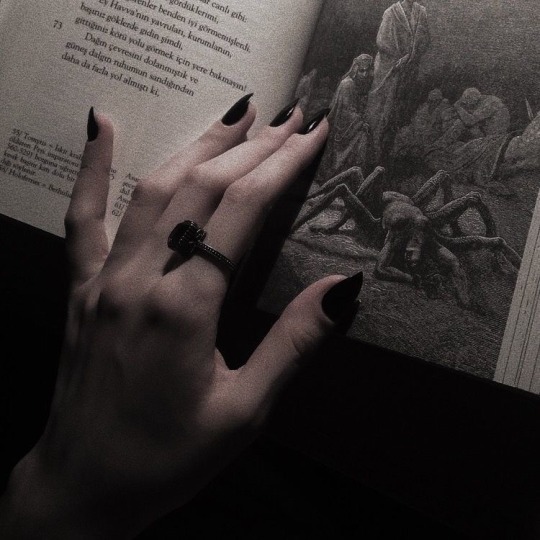
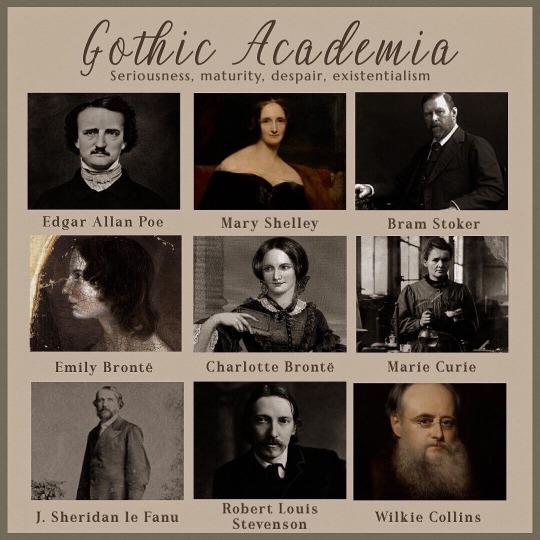


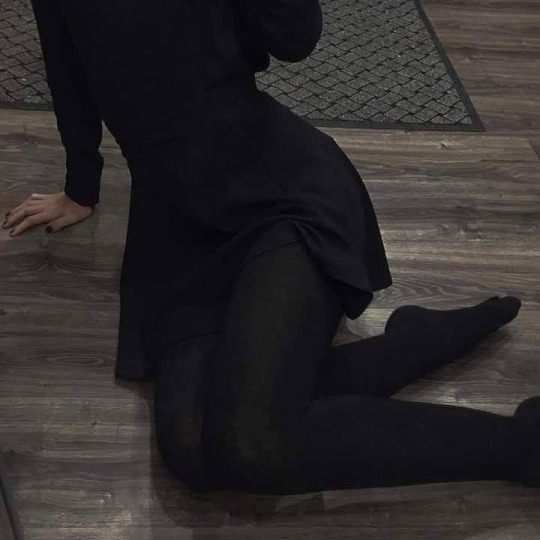

Gothic Academia
#dark academia#aesthetic#dark aesthetic#witch#witchblr#dark academia books#witchcraft#dark poetry#if we were villains#the secret history#gothic#goth aesthetic#gothic aesthetic#gothic academia#darkest academia#the darkest minds#fyodor dostoevsky#crime and punishment#oscar wilde#picture of dorian gray#mary shelley#frankenstein#percy shelley#edgar allan poe#nevermore#bram stoker#count dracula#dracula daily#bram stocker's dracula#dante
248 notes
·
View notes
Text

“My life is a perfect graveyard of buried hopes.”
― L.M. Montgomery
Painting by Liza Sivakova
#albert camus#franz kafka#poetry#sylvia plath#classical quotes#quotes#classics#literature#classical literature#booklr#dostoevksy#fyodor dostoevsky#crime and punishment#notes from underground#brothers karamazov#dark academia quotes#dark academia#dark acamedia#dark acadamia aesthetic#dark academism#the secret history#dead poets society#charles bukowski#book quote#books#bookblr#lit#literary quotes#classic literature
141 notes
·
View notes
Text
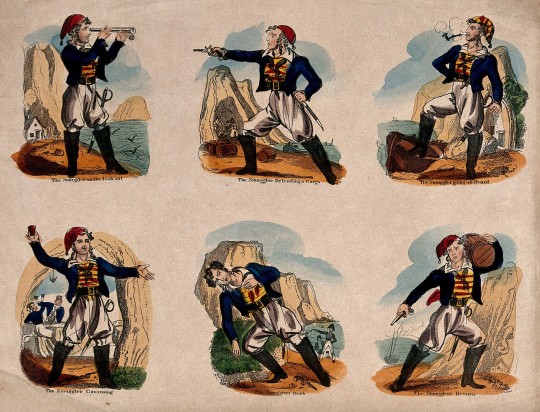
'A smuggler shown at different stages and points of his chosen profession', 19th century coloured etching (Wellcome Collection).
Odd choice to depict "The Smuggler's Death" at bottom centre followed by "The Smuggler's Return," when reading left to right. No matter what direction you go, death is but a temporary obstacle in his career.
#age of sail#smuggling#maritime history#you expect to see a life of crime punished in this type of print#but actually he's immortal
147 notes
·
View notes
Text
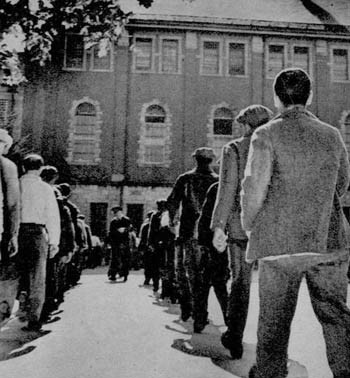
"The Progressives’ design for the penitentiary did alter the system of incarceration. Their ideas on normalization, classification, education, labor, and discipline had an important effect upon prison administration. But in this field, perhaps above all others, innovation must not be confused with reform. Once again, rhetoric and reality diverged substantially. Progressive programs were adopted more readily in some states than in others, more often in industrialized and urban areas, less often in southern, border, and mountain regions. Nowhere, however, were they adopted consistently. One finds a part of the program in one prison, another part in a second or in a third. Change was piecemeal, not consistent, and procedures were almost nowhere implemented to the degree that reformers wished. One should think not of a Progressive prison, but of prisons with more or less Progressive features.
The change that would have first struck a visitor to a twentieth-century institution who was familiar with traditional practices, was the new style of prisoners’ dress. The day of the stripes passed, outlandish designs gave way to more ordinary dress. It was a small shift, but officials enthusiastically linked it to a new orientation for incarceration. In 1896 the warden of Illinois’s Joliet prison commented that inmates “should be treated in a manner that would tend to cultivate in them, spirit of self-respect, manhood and self-denial. . . , We are certainly making rapid headway, as is shown by the recently adopted Parole Law and the abolishment of prison stripes.” In 1906, the directors of the New Hampshire prison, eager to follow the dictates of the “science of criminology” and “the laws of modern prisons,” complained that “the old unsightly black and red convict suit is still used. . . . This prison garb is degrading to the prisoner and in modern prisons is no longer worn.” The uniform should be grey: “Modern prisons have almost without exception adopted this color.” The next year they proudly announced that the legislature had approved an appropriation of $700 to cover the costs of the turnover. By the mid-1930’s the Attorney General’s survey of prison conditions reported that only four states (all southern) still used striped uniforms. The rest had abandoned “the ridiculous costumes of earlier days.”
To the same ends, most penitentiaries abolished the lock step and the rules of silence. Sing-Sing, which had invented that curious shuffle, substituted a simple march. Pennsylvania’s Eastern State Penitentiary, world famous for creating and enforcing the silent system, now allowed prisoners to talk in dining rooms, in shops, and in the yard. Odd variations on these practices also ended. “It had been the custom for years,” noted the New Hampshire prison directors, “not to allow prisoners to look in any direction except downward,” so that “when a man is released from prison he will carry with him as a result of this rule a furtive and hang-dog expression.” In keeping with the new ethos, they abolished the regulation.
Concomitantly, prisons allowed inmates “freedom of the yard,” to mingle, converse, and exercise for an hour or two daily. Some institutions built baseball fields and basketbaIl courts and organized prison teams. “An important phase in the care of the prisoner,” declared the warden of California’s Folsom prison, “is the provisions made for proper recreation. Without something to look forward to, the men would become disheartened. . . . Baseball is the chief means of recreation and it is extremely popular.” The new premium on exercise and recreation was the penitentiary’s counterpart to the Progressive playground movement and settlement house athletic clubs.
This same orientation led prisons to introduce movies. Sing Sing showed films two nights a week, others settled for once a week, and the warden or the chaplain usually made the choice. Folsom’s warden, for example, like to keep them light: “Good wholesome comedy with its laugh provoking qualities seems to be the most beneficial.” Radio soon appeared as well. The prisons generally established a central system, providing inmates with earphones in their cells to listen to the programs that the administration selected. The Virginia State Penitentiary allowed inmates to use their own sets, with the result that, as a visitor remarked “the institution looks like a large cob-web with hundreds of antennas, leads and groundwires strung about the roofs and around the cell block.”
Given a commitment to sociability, prisons liberalized rules of correspondence and visits. Sing-Sing placed no restrictions on the number of letters, San Quentin allowed one a day, the New Jersey penitentiary at Trenton permitted six a month. Visitors could now come to most prisons twice a month and some institutions, like Sing-Sing, allowed visits five times a month. Newspapers and magazines also enjoyed freer circulation. As New Hampshire’s warden observed in 1916: “The new privileges include newspapers, that the men may keep up with the events of the day, more frequent writing of letters and receiving of letters from friends, more frequent visits from relatives . . . all of which tend to contentment and the reestablishment of self-respect.’? All of this would make the prisoners’ “life as nearly normal as circumstances will permit, so that when they are finally given their liberty they will not have so great a gap to bridge between the life they have led here . . . and the life that we hope they are to lead.”
These innovations may well have eased the burden of incarceration. Under conditions of total deprivation of liberty, amenities are not to be taken lightly. But whether they could normalize the prison environment and breed self-respect among inmates is quite another matter. For all these changes, the prison community remained abnormal. Inmates simply did not look like civilians; no one would mistake a group of convicts for a gathering of ordinary citizens. The baggy grey pants and the formless grey jacket, each item marked prominently with a stenciled identification number, became the typical prison garb. And the fact that many prisons allowed the purchase of bits of clothing, such as a sweater or more commonly a cap, hardly gave inmates a better appearance. The new dress substituted one kind of uniform for another. Stripes gave way to numbers.
So too, prisoners undoubtedly welcomed the right to march or walk as opposed to shuffle, and the right to talk to each other without fear of penalty. But freedom of the yard was limited to an hour or two a day and it was usually spent in “aimless milling about.” Recreational facilities were generally primitive, and organized athletic programs included only a handful of men. More disturbing, prisoners still spent the bulk of non-working time in their cells. Even liberal prisons locked their men in by 5:30 in the afternoon and kept them shut up until the next morning. Administrators continued to censor mail, reading materials, movies, and radio programs; their favorite prohibitions involved all matter dealing with sex or communism. Inmates preferred eating together to eating alone in a cell. But wardens, concerned about the possibility of riots with so many inmates congregated together, often added a catwalk above the mess hall and put armed guards on patrol.
Prisoners may well have welcomed liberalized visiting regulations, but the encounters took place under trying conditions. Some prisons permitted an initial embrace, more prohibited all physical contact. The rooms were dingy and gloomy. Most institutions had the prisoner and his visitor talk across a table, generally separated by a glass or wire mesh. The more security-minded went to greater pains. At Trenton, for example, bullet-proof glass divided inmate from visitor; they talked through a perforated metal opening in the glass. Almost everywhere guards sat at the ends of the tables and conversations had to be carried on in a normal voice; anyone caught whispering would be returned to his cell. The whole experience was undoubtedly more frustrating than satisfying.
The one reform that might have fundamentally altered the internal organization of the prison, Osborne’s Mutual Welfare League, was not implemented to any degree at all. The League persisted for a few years at Sing-Sing, but a riot in 1929 gave guards and other critics the occasion to eliminate it. One couId argue that inmate self-rule under Osborne was little more than a skillful exercise in manipulation, allowing Osborne to cloak his own authority in a more benevolent guise. It is unnecessary, however, to dwell on so fine a point. Wardens were simply not prepared to give over any degree of power to inmates. After all, how could men who had already abused their freedom on the outside be trusted to exercise it on the inside? Administrators also feared, not unreasonably, that inmate rule would empower inmate gangs to abuse fellow prisoners. In brief, the concept of a Mutual Welfare League made little impact on prison systems throughout this period.
If prisons could not approximate a normal community, they fared no better in attempting to approximate a therapeutic community. Again, reform programs frequently did alter inherited practices but they inevitably fell far short of fulfilling expectations. Prisons did not warrant the label of hospital or school.
Starting in the 1910’s and even more commonly through the 1920's, state penitentiaries established a period of isolation and classification for entering inmates. New prisoners were confined to a separate building or cell block (or occasionally, to one institution in a complex of state institutions); they remained there for a two- to four-week period, took tests and underwent interviews, and then were placed in the general prison population. In the Attorney General’s Survey of Release Procedures: Prisons forty-five institutions in a sample of sixty followed such practices. Eastern State Penitentiary, for example, isolated newcomers for thirty days under the supervision of a classification committee made up of two deputy wardens, the parole officer, a physician, a psychiatrist, a psychologist, the educational director, the social service director, and two chaplains. The federal government’s new prison at Lewisburg, Pennsylvania, opened in 1932 and, eager to employ the most modern principles, also followed this routine. All new prisoners were on “quarantine status,” and over the course of a month each received a medical examination, psychometric tests to measure his intelligence, and an interview with the Supervisor of Education. The Supervisor then decided on a program, subject to the approval of its Classification Board. All of this was to insure “that an integrated program . . . may lead to the most effective adjustment, both within the Institution and after discharge.”
It was within the framework of these procedures that psychiatrists and psychologists took up posts inside the prisons for the first time. The change can be dated precisely. By 1926, sixty-seven institutions employed psychiatrists: thirty-five of them made their appointments between 1920 and 1926. Of forty-five institutions having psychologists, twenty-seven hired them between 1920 and 1926. The innovation was quite popular among prison officials. “The only rational method of caring for prisoners,” one Connecticut administrator declared, “is by classifying and treating them according to scientific knowledge . . . [that] can only be obtained by the employment of the psychologist, the psychiatrist, and the physician.” In fact, one New York official believed it “very unfair to the inmate as well as to the institution to try and manage an institution of this type without the aid of a psychiatrist.”
Over this same period several states also implemented greater institutional specialization. Most noteworthy was their frequent isolation of the criminal insane from the general population. In 1904, only five states maintained prisons for the criminally insane; by 1930, twenty-four did. At the same time, reformatories for young first offenders, those between the ages of sixteen and twenty-five or sixteen and thirty, became increasingly popular. In 1904, eleven states operated such facilities; in 1930, eighteen did. Several states which constructed new prisons between 1900 and 1935 attempted to give each facility a specific assignment. No state pursued this policy more diligently than New York. It added Great Meadow (Comstock), and Attica to its chain of institutions, the first two to service minor offenders, the latter, for the toughest cases. New York‘s only rival was Pennsylvania. By the early 1930’s it ran a prison farm on a minimum security basis; it had a new Eastern State Penitentiary at Grateford and the older Western State Penitentiary at Pittsburgh for medium security; and it made the parent of all prisons, the Eastern State Penitentiary at Philadelphia, the maximum security institution. Some states with two penitentiaries which traditionally had served different geographic regions, now tried to distinguish them by class of criminals. In California, for instance, San Quentin was to hold the more hopeful cases, Folsom the hard core.
But invariably, these would-be therapeutic innovations had little effect on prison routines. They never managed to penetrate the system in any depth. Only a distinct minority of institutions attempted to implement such programs and even their efforts produced thin results. Change never moved beyond the superficial."
- David J. Rothman, Conscience and Convenience: The Asylum and Its Alternatives in Progressive America. Revised Edition. New York: Aldine de Gruyter, 2002 (1980), p. 128-134
#penal reform#progressive penology#progressive politics#rehabilitation#penal modernism#american prison system#penology#prison sports#prison community#prison discipline#convict uniforms#prison routine#classification and segregation#history of crime and punishment#mutual welfare league#utopia of classification#academic quote#reading 2023#david rothman
25 notes
·
View notes
Text
"Talk nonsense , but talk your own nonsense, and I'll kiss you for it. To go wrong in your own way is better than to go right in someone else's."
- Fyodor Dostoevsky , "Crime and Punishment"@silentroad
#fyodor dostoevsky#poetry#crime and punishment#literature#art#dark academia#lit#writing#relatable#writers and poets#writing community#spilled ink#spilled poetry#books and libraries#history#russian#poets on tumblr#russian novelist
340 notes
·
View notes
Text
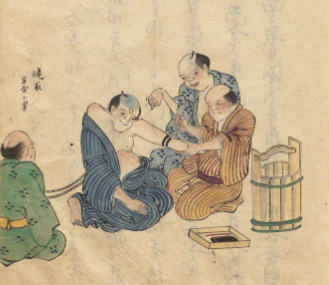
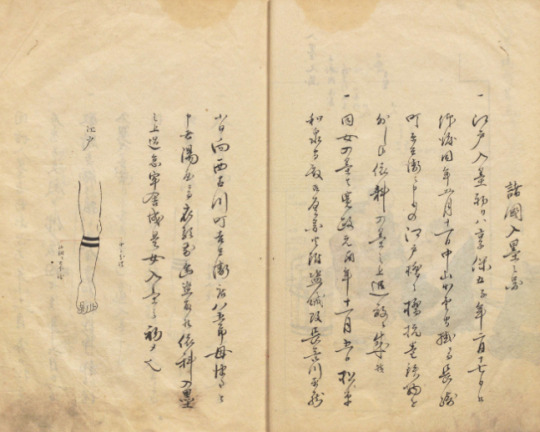
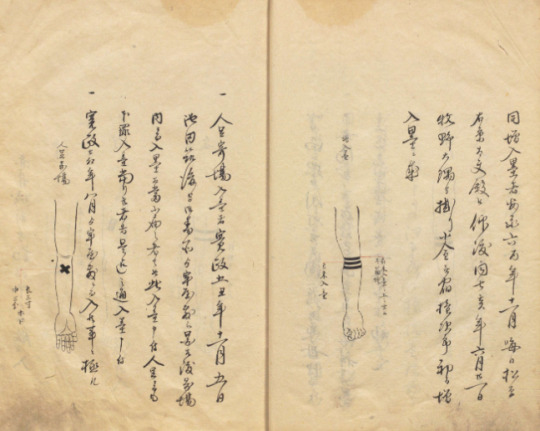

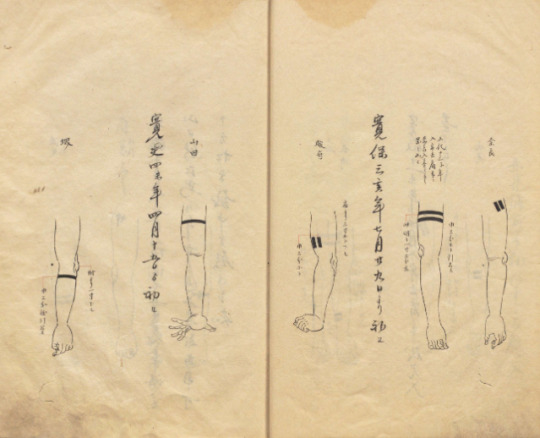
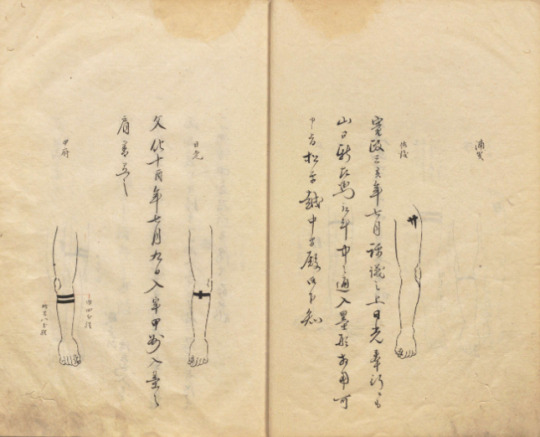
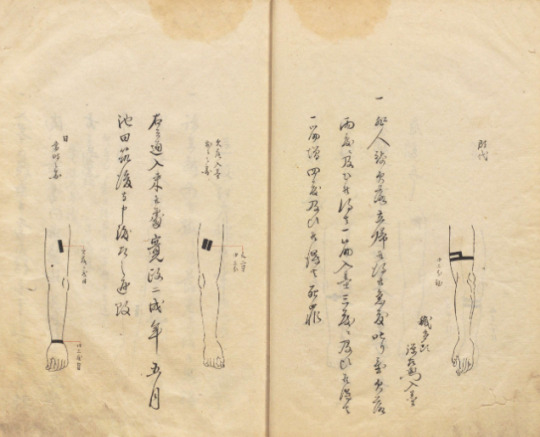
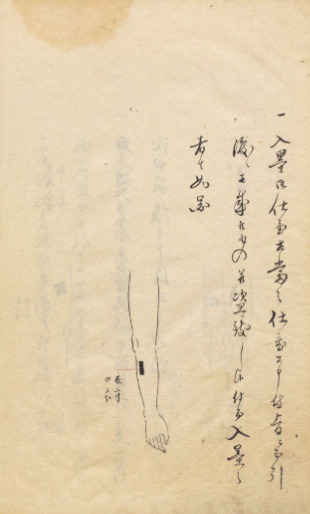
Irezumi kei (tattoo penalty) as depicted in the [徳鄰厳秘録 - Tokuringenbiroku], a kind of penalty instruction book compiled in 1814, digitalized by the National Archives of Japan.
CW for this post about Edo period judiciary => mentions of physical punishment, torture, death penalty (text only, no details, no graphic illustrations) . The irezumikei pages above are p.19 to 25.
I won't reproduced the illustrations here, but the Tokuringenbiroku book also presents other Edo period "punishments" and death penalties, like different types of goumon (torture), gokumon (decapitation and exposure of the head to public view), kakei (stake), haritsuke (crucifixion), or tameshigiri (sword cut testing, here on executed convict corpse).
Please proceed to the full book according to your sensibilities!
Back to irezumi kei : the markings of character Akaza (from Kimetsu no Yaiba/Demon's Slayer) are directly inspired by those, same for Mugen in Samurai Champloo for example:

After Tokugawa Yoshimune's reforms abolished bloodier punishments (nose or ear cutting) for lesser crimes (like theft, gambling or fraud), irezumikei spread, inspired by Chinese bokkei practices.
Yet, zainin (lawbreakers) were also often beaten or whipped (tataki), which could be a "light" sentence or more far extreme one. Women tended to be imprisoned instead.
Punishment tattoos also often went alongside tokorobarai (banishment), which had several levels depending on the crime. You could be banished to a remote island, just away from your city, or forbidden to enter a certain perimeter.
Exile is why different areas had different marks, placed on the arms or faces, easily identifying the person as a criminal convicted in another region.
Number of lines or dots were often used to symbolize repeated offences (pic below source). Most of the times, getting 3+ irezumikei could grant you death penalty.
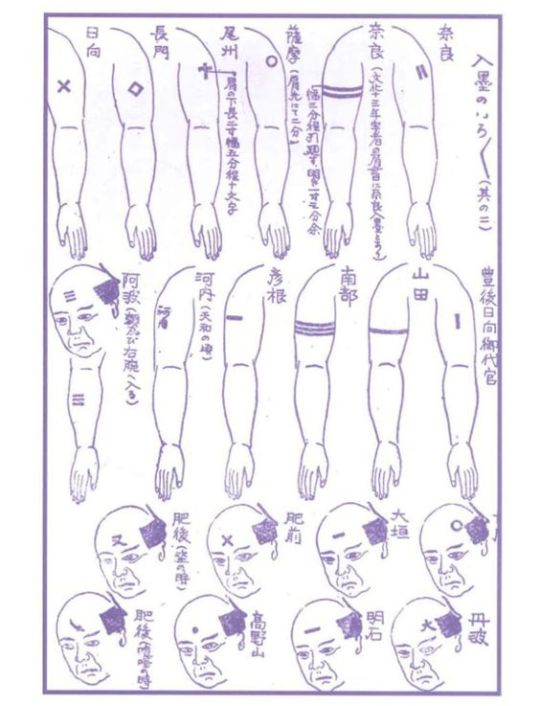
Irezumikei maybe be why criminals came to use extravagant tattoos, as to cover their infamous marks, leading to the yakuza association with body ink.
Yet, other strata of population also favored figurative tattoos, so the link between criminals and tattoing in Edo period is not self-evident.
Some shapes of -sode (sleeve part of a tattoo) for example left arm interior bare, maybe to prove then that no armband tattoo was hidden underneath a bigger design.
#japan#japanese history#Edo period#crimes#judiciary#theft#fraud#cw: physical punishment#cw: torture#cw: death penalty#irezumi#Japanese tattoo#horimono#irezumikei#criminal tattoo#yakuza#tokorobarai#tataki#gokumon#kakei#haritsuke#tameshigiri#徳鄰厳秘録#Tokuringenbiroku
305 notes
·
View notes
Text

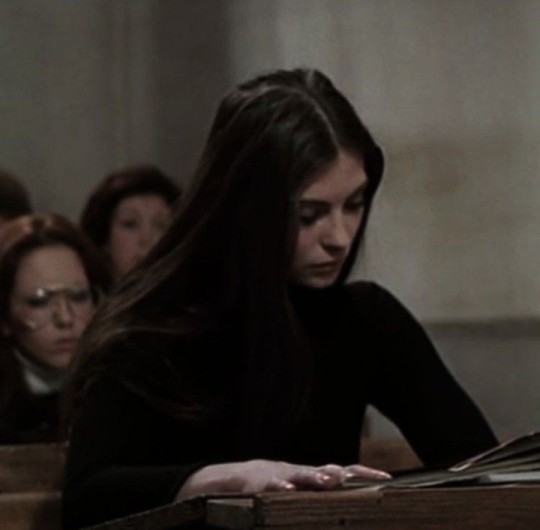

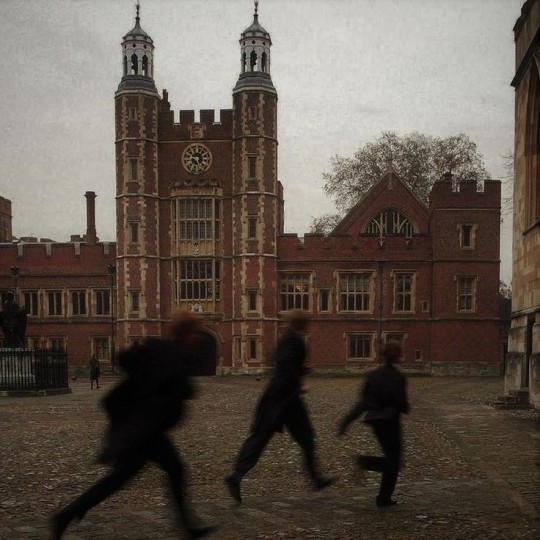
"I notice autumn is more the season of the soul than of nature."
Friedrich Nietzsche
#classic academia#dark acadamia aesthetic#crime and punishment#fall aesthetic#autumn vibes#the secret history#classic books#autumn#books and libraries#books and coffee#books and reading#books and literature#university
195 notes
·
View notes
Text
Yes, I do put Dostoevsky on as an audiobook to fall asleep. Why do you ask?
#academia#chaotic academia#classic academia#dark academia#literature#aesthetic#english literature#uni#college#lit#fyodor dostoyevsky bsd#dostoyevski#fyodor dostoyevsky x reader#fyodor dostoyevsky fanart#fyodor dostoyesky#crime and punishment#academic weapon#dark acamedia#dark acadamia aesthetic#light academia#academia aesthetic#academics#chaotic academic aesthetic#romantic academia#green academia#chaotic good#chaos#tsh#the secret history aesthetic#the secret history
68 notes
·
View notes